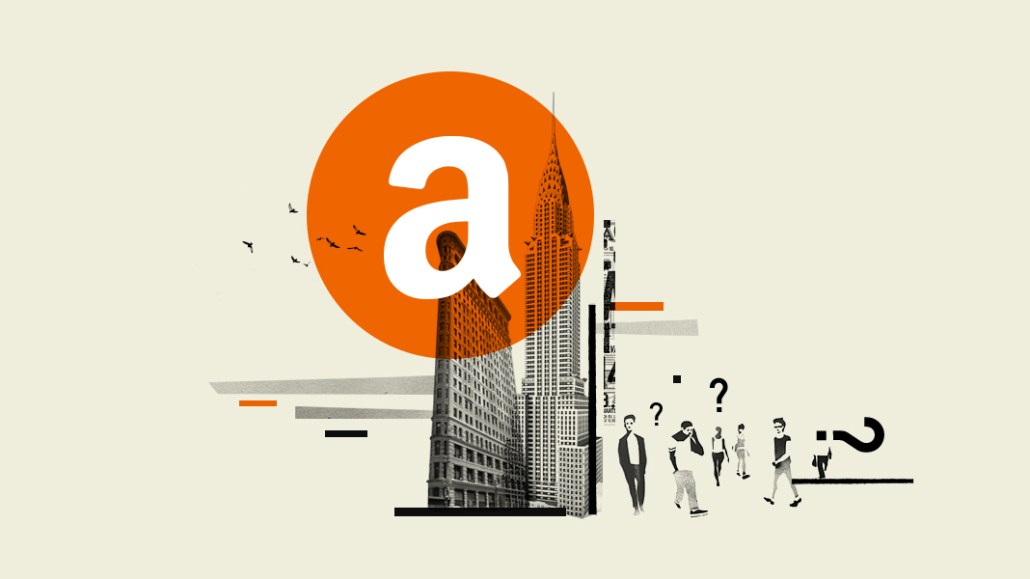Save 50% on a 3-month Digiday+ membership. Ends Dec 5.
‘The tech is good enough’: Why Amazon’s DSP is becoming a rival to Google

The Digiday Programmatic Media Summit is taking place in New Orleans next month. For information on how to attend or sponsor the summit, click here.
Google is still the most dominant company in ad tech, but Amazon is gaining on the search giant. One example of this is the growing use of Amazon’s demand-side platform.
Amazon’s DSP is gaining traction because it pitches agencies a self-service option, low fees and most importantly, unique commerce and purchase data that advertisers crave. Data from three ad-research firms indicates that Amazon’s DSP is gaining adoption among ad buyers and its market penetration is in the same ballpark as Google’s DSP DoubleClick Bid Manager.
“Campaigns just perform better on Amazon than on any other DSP, as targeting an audience based on known shopping history outperforms contextual relevancy of an ad,” said Abe Curry, a senior strategist at ad agency Possible, who previously spent four years at Amazon managing advertiser accounts.
A year ago, Amazon’s DSP wasn’t popular enough for research firm Advertiser Perceptions to include Amazon in its survey about DSP usage. But in its most recent survey of 700 ad buyers, Amazon tied Google for having the highest adoption rate among agencies. Amazon declined an interview request for this story.
The number of brands using Amazon’s DSP has grown nearly 50 percent this year, more than any other buy-side tech platforms, according to MediaRadar (it wouldn’t say how many brands were actually using the DSP, though). Pathmatics data shows that only Google has more websites featuring its buy-side ad tech tags than Amazon.
Similar to how chips are merely a conduit for guacamole, the data that lives within the DSP, not the ad-buying platform itself, is what advertisers seek. Advertisers who want to upload their own data or rely on aggregators like Acxiom are more apt to use DSPs like The Trade Desk or MediaMath for those campaigns. But when programmatic ad buyers want robust user data they can’t get anywhere else, they tend to turn to Amazon and Google, said Nichola Perrigo, director of digital marketing at ad agency RPA.
Ad position: web_incontent_pos1
“In Amazon’s case, the data is great, especially for Amazon commerce partners, and the tech is good enough,” said Adam Heimlich, svp of programmatic at media at media-buying shop Horizon.
Amazon has gotten a lot of attention lately for sinking its hooks into the media industry. The e-commerce giant is growing its sales team, courting video publishers, getting frequently mentioned during quarterly earnings calls and hiring 2,000 people to work in its new office in New York City.
But while the internet behemoth makes headlines for getting Academy Awards, Amazon has been growing the unsexy side of its business to become a powerful force in ad tech. Aside from its growing DSP business, the company is opening up self-service programmatic ad products and offering training programs to make direct connections with ad buyers. Its Transparent Ad Marketplace is the most popular server-to-server wrapper in the ad industry, according to a ServerBid study.
Amazon’s DSP growth is happening while ad buyers are cutting back the number of DSPs they use. A major reason the DSP herd is thinning is because self-service is on the rise in ad tech, as marketers try to trim fees by moving from high-margin managed-service vendors to low-margin self-service vendors.
Amazon has benefited from this trend. It pitches agencies a self-serve model, and its DSP fees are among the lowest in the market, said John Lockmer, director of programmatic ad operations at marketing consultancy DuMont Project.
Ad position: web_incontent_pos2
While Amazon’s DSP has become more popular, it also has drawbacks for buyers.
Certain types of targeted ads can only be used if they drive users back to Amazon pages, and it restricts ads from sending users to other retailers, Lockmer said. For example, ads bought with Amazon’s DSP won’t link out to Costco.com, but they can link out to a site for a specific brand like Nike.com.
The reporting on Amazon’s DSP also lacks full transparency, and its dashboard is harder to navigate than other DSPs, said Dan de Sybel, CTO of programmatic agency Infectious Media, which stopped using Amazon’s DSP a few months ago due to its lack of transparency. But despite these flaws, many agencies continue to use the platform.
“For brand objectives, you don’t need a smart campaign set up; it’s all about the data,” he said. “That’s why uptake of its DSP has been expanding rapidly.”
More in Marketing

Ulta, Best Buy and Adidas dominate AI holiday shopping mentions
The brands that are seeing the biggest boost from this shift in consumer behavior are some of the biggest retailers.

U.K. retailer Boots leads brand efforts to invest in ad creative’s data layer
For media dollars to make an impact, brands need ad creative that actually hits. More CMOs are investing in pre- and post-flight measurement.

‘AI is permeating everything we do’: How Guitar Center developed 2 AI tools this year
This summer, the company launched a chatbot called Rig Advisor to help customers find the right instruments and products.
Ad position: web_bfu
